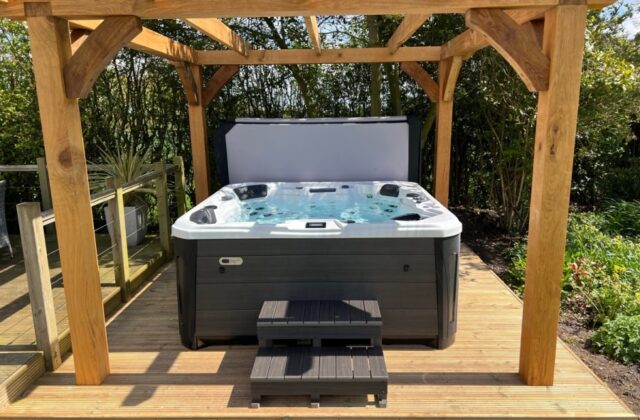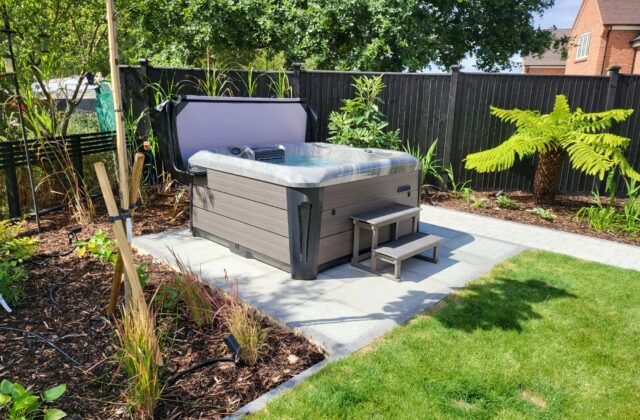Eine der häufigsten Fragen, die potenzielle Whirlpool-Besitzer stellen, lautet: „Wie lange dauert das Aufheizen eines Whirlpools?“. Das ist sinnvoll, denn selbst wenn Sie Ihren Whirlpool zum ersten Mal füllen, sollten Sie dies tun Entleerung und füllen Sie Ihren Whirlpool drei- bis viermal im Jahr nach, wenn Sie einen empfohlenen Reinigungsplan einhalten.
In diesem Artikel erfahren Sie, wie lange das Aufheizen eines Whirlpools dauert, welche Faktoren Einfluss darauf haben, wie lange es dauert, und ein paar Tipps, die Sie umsetzen können, um den Prozess zu beschleunigen.
Wie lange dauert das Aufheizen eines Whirlpools?
Es kann bis zu 12 Stunden dauern, bis ein Whirlpool das Wasser vollständig auf die ideale Temperatur erwärmt hat. Es gibt jedoch mehrere Faktoren, die die Dauer dieses Vorgangs beeinflussen, wie zum Beispiel die Größe des Whirlpools, die Außentemperatur und die Qualität der Isolierung Ihres Whirlpools.
Was beeinflusst die Aufheizzeit eines Whirlpools?
Die Größe Ihres Whirlpools
Das scheint offensichtlich, aber ein größerer Whirlpool benötigt mehr Wasser und braucht daher länger, um die Temperatur zu erreichen, als ein kleinerer Whirlpool. Beim Kauf eines Whirlpools sollten Sie die Größe des Whirlpools und die Anzahl der Personen berücksichtigen, die ihn hauptsächlich nutzen werden. Sie verschwenden viel Zeit und Geld mit dem Aufheizen eines Whirlpools für 8 Personen, wenn Sie ihn nur zu dritt regelmäßig nutzen.
Wenn beim Whirlpool nicht angegeben ist, wie viele Personen in ihn passen, können Sie dies anhand der Wasserkapazität berechnen. Als grober Richtwert gelten etwa 250 Liter Wasser pro Person. Ein 1000-Liter-Whirlpool ist also ungefähr für 4 Personen geeignet.
Die Leistung der Heizung Ihres Whirlpools
Normalerweise sollte Ihr Whirlpool je nach Größe des Whirlpools über eine entsprechend leistungsstarke Heizung verfügen. Wenn Sie für einen großen Whirlpool eine nicht sehr leistungsstarke Heizung haben, dauert es deutlich länger, bis das Wasser die ideale Temperatur von 36–38 Grad Celsius erreicht.
Eine leistungsstarke Heizung in einem kleineren Whirlpool verkürzt zwar die Aufheizzeit, erhöht aber auch die Kosten für Ihre Energierechnung. Bedenken Sie, dass Sie Ihren Whirlpool im Durchschnitt nur drei bis vier Mal pro Jahr vollständig auffüllen müssen.
Solange Sie das Baden und Auffüllen Ihres Whirlpools so planen, dass Sie nicht darauf warten müssen, dass er sich aufheizt, macht die Entscheidung für eine zu leistungsstarke Heizung keinen allzu großen Unterschied.
Die Qualität der Isolierung Ihres Whirlpools
Ein Whirlpool mit durchgehend hochwertiger Isolierung erhöht die im Whirlpool und im Wasser gespeicherte Wärmemenge deutlich. Das bedeutet, dass beim Aufheizen Ihres Whirlpools weniger Wärme verloren geht und das Aufheizen daher nicht so lange dauert.
In der Regel sind Whirlpools mit besserer Isolierung teurer. Es lohnt sich jedoch, etwas länger zu sparen und das Budget zu erhöhen, um sich einen Whirlpool mit guter Isolierung anzuschaffen. Mit günstigeren Whirlpools können Sie zwar von vornherein Geld sparen, aber das zusätzliche Geld, das Sie für die Energierechnung ausgeben, übersteigt mit der Zeit die ursprüngliche Ersparnis. Denken Sie darüber nach, etwas mehr Geld für einen gut isolierten Whirlpool auszugeben, um langfristig Geld zu sparen.
Unser Premium-Sortiment Und Deluxe-Reihe Whirlpools nutzen unsere preisgekrönte Isolierung, Platin-Premiumschild. Dabei werden 5 verschiedene Isolierungsarten verwendet, um den Wärmeverlust zu minimieren und Ihnen Geld bei Ihren Energiekosten zu sparen.
Die Qualität der Abdeckung Ihres Whirlpools
Eine hochwertige Abdeckung für Ihren Whirlpool kann einen großen Unterschied darin machen, wie energieeffizient Ihr Whirlpool ist und wie lange es dauert, bis er sich aufheizt. Bis zu 601 TP3T des Wärmeverlusts eines Whirlpools erfolgt über die Wasseroberfläche. Dies macht durchaus Sinn, wenn man darüber nachdenkt, da es die größte Oberfläche hat, die der Luft ausgesetzt ist.
Eine hochwertige Abdeckung sollte mindestens 10 cm dick sein und aus hochdichtem Schaumstoff wie Polyurethan bestehen, der als dicke Isolierschicht dient. Darüber hinaus sollte die Abdeckung über eine durchgehende, luftdichte Heißsiegelung verfügen, die dazu beiträgt, heiße Luft drinnen und kalte Luft draußen zu halten. Schließlich sollte Ihre Abdeckung an den Rändern verjüngt sein, damit Regen und Schnee ablaufen können.
Die Außentemperatur
Ein großer Einfluss darauf, wie lange es dauert, bis Ihr Whirlpool aufgeheizt ist, ist die Außentemperatur. Das mag offensichtlich erscheinen, aber ein Whirlpool in einer kälteren Umgebung braucht länger, um die Temperatur zu erreichen, als ein Whirlpool in einer heißen Umgebung.
Faktoren wie die Wind- und Regeneinwirkung Ihres Whirlpools wirken sich auch darauf aus, wie lange es dauert, bis Ihr Whirlpool aufgeheizt ist. Ein Whirlpool mit hochwertiger Isolierung und einer guten Abdeckung, wie oben erwähnt, kann dazu beitragen, die Auswirkungen der äußeren Bedingungen teilweise abzumildern.
Die Anfangstemperatur des Wassers
Die Ausgangstemperatur des Wassers bestimmt auch, wie lange es dauert, bis ein Whirlpool die richtige Temperatur erreicht. Das bedeutet jedoch nicht, dass Sie mit einem kochenden Wasserkocher in der Küche hin und her rennen sollten.
Aufgrund des schieren Kapazitätsunterschieds hat dies nicht nur nur minimale Auswirkungen, sondern könnte auch möglicherweise die Hülle Ihres Whirlpools beschädigen. Whirlpools sind nicht für extrem hohe Temperaturen geeignet, da die Wassertemperatur darin normalerweise nicht über 40 Grad Celsius liegt.
Sparen Sie lieber Zeit und Energie beim Betrieb des Wasserkochers und lassen Sie Ihren Whirlpool seine Arbeit machen.
Der Zustand Ihres Whirlpools
Der Zustand Ihres Whirlpools spielt eine Rolle dabei, wie lange es dauert, bis er aufgeheizt ist. Insbesondere der Zustand der Heizung wird einen großen Unterschied machen. Eine abgenutzte Heizung ist beim Erhitzen von Wasser viel weniger effizient, weshalb es wichtig ist, Ihren Whirlpool regelmäßig von einem Fachmann warten zu lassen.
Das bedeutet, dass die Heizelemente, Filter und Düsen in gutem Zustand bleiben und effizient bleiben. Wir empfehlen Ihnen, Ihren Whirlpool mindestens einmal im Jahr von einem Fachmann warten zu lassen. Nicht nur die mechanischen Elemente müssen in gutem Zustand sein, auch Risse oder Schäden an der Abdeckung können dazu beitragen, dass der Wärmeverlust eines Whirlpools zunimmt. Es lohnt sich, die Abdeckung regelmäßig zu überprüfen, um sicherzustellen, dass sie noch in gutem Zustand ist.
Tipps zur Verbesserung der Aufheizzeit Ihres Whirlpools
Während die oben genannten Punkte Einfluss darauf haben, wie lange es dauert, bis Ihr Whirlpool aufgeheizt ist, gibt es einige Tipps und Tricks, die Sie anwenden können, um den Prozess zu beschleunigen.
Lassen Sie Ihren Whirlpool eingeschaltet
Auch wenn es kontraintuitiv klingt, ist Ihr Whirlpool energieeffizienter, wenn Sie ihn eingeschaltet lassen und die Temperatur aufrechterhalten. Dies liegt daran, dass das Erwärmen von Wasser aus Kälte wesentlich mehr Energie benötigt, als es auf einer warmen Temperatur zu halten.
Abgesehen von vierteljährlichen Abflüssen oder vielleicht, wenn Sie den Whirlpool für den Winter außer Betrieb nehmen, wenn Sie ihn nicht so oft benutzen, ist es viel besser, den Whirlpool eingeschaltet und voll zu lassen. Das bedeutet, dass Sie nur ein paar Mal im Jahr lange auf die Erwärmung warten müssen!
Nutzen Sie Windschutz und Schutz
Um den Auswirkungen von Wind, Regen und den kälteren Umgebungstemperaturen entgegenzuwirken, können Sie Windschutze verwenden, um Ihren Whirlpool zu schützen und ihn so wärmer zu halten.
Windschutz
Als Windschutz können Sie Ihren Whirlpool entweder in einer natürlichen Nische aufstellen, sofern Sie eine haben, oder Sie können Windschutze selbst anbringen. Eine Möglichkeit hierfür ist das Pflanzen von Hecken oder Sträuchern, die als natürliche Barriere gegen den Wind wirken können. Eine andere Möglichkeit besteht darin, Holzpaneele wie Spaliere zu verwenden, um eine teilweise Umzäunung des Whirlpools zu schaffen.
Windschutze tragen nicht nur dazu bei, den Whirlpool wärmer zu halten, sondern sorgen auch für mehr Privatsphäre, was dazu beitragen kann, dass Ihr Whirlpool-Erlebnis insgesamt angenehmer wird.
Schutz
Eine beliebte Option für Menschen, die über ausreichend Platz verfügen, ist die Überdachung ihres Whirlpoolbereichs. Diese können oft aus Holz und anderen Materialien hergestellt werden und passen optisch zur Verwendung von Holzspalieren rund um Ihren Whirlpool.
Ein Dach hält nicht nur Schnee und Regen von Ihrem Whirlpool fern, sondern trägt auch dazu bei, die Windstärke zu reduzieren.
Benutzen Sie die Düsen zum Heizen Ihres Whirlpools
Dieses Thema kann manchmal zu Diskussionen führen, da durch die Düsen in einem Whirlpool Luft in das Wasser gelangt, die es leicht abkühlt. Das bedeutet, dass das Heizelement mehr arbeiten muss, um die Temperatur aufrechtzuerhalten.
Wenn Sie jedoch beim ersten Aufheizen Ihres Whirlpools regelmäßig die Düsen verwenden, kann dies dazu beitragen, das Wasser zirkulieren zu lassen und sicherzustellen, dass keine kalten Stellen entstehen. Der Einsatz der Düsen kann auch dazu beitragen, die Bildung von Kältetaschen in den Rohren zu reduzieren. Dabei sollten Sie die Düsen nicht ständig eingeschaltet lassen, sondern sie in kurzen Stößen einschalten, sobald sich das Wasser zu erwärmen beginnt.
Abschluss
Die Aufheizzeit eines Whirlpools beträgt etwa 12 Stunden, bei einer Geschwindigkeit von 1–2 Grad Celsius pro Stunde. Es gibt viele Faktoren, die sich darauf auswirken können, wie z. B. die Größe Ihres Whirlpools, die Außentemperatur und die Qualität der Isolierung Ihres Whirlpools.
Sie können zusätzliche Elemente wie Windschutze einbauen, um zu verhindern, dass der Wind die Temperatur des Whirlpools weiter beeinflusst. Darüber hinaus tragen Sie dazu bei, die Energieeffizienz zu steigern, indem Sie Ihren Whirlpool pflegen und in einem guten Zustand halten.
Suchen Sie einen hochwertigen Whirlpool?
Hier bei Platinum Spas sind wir stolz auf die Qualität unserer Produkte Whirlpools. Wir bieten eine Reihe von Größen an, von 3-Personen Whirlpools, zu 8 Personen Whirlpools. Alle unsere Whirlpools zeichnen sich durch fantastische Qualität und Handwerkskunst aus und tragen dazu bei, dass Ihr Whirlpool-Erlebnis noch angenehmer und entspannender wird.
In Kontakt kommen Sprechen Sie noch heute mit einem unserer Teammitglieder und wir helfen Ihnen dabei, den perfekten Whirlpool zu finden, der Ihren Bedürfnissen entspricht.
Häufig gestellte Fragen
Wie lange dauert es, einen Whirlpool aufzuheizen?Es kann bis zu 12 Stunden dauern, bis ein Whirlpool aufgeheizt ist, nachdem er mit frischem Wasser gefüllt wurde. Die Temperatur steigt um etwa 1–2 Grad Celsius pro Stunde, bis die gewünschte Temperatur erreicht ist. Faktoren wie die Außentemperatur, der Grad der Isolierung Ihres Whirlpools und die Größe Ihres Whirlpools bestimmen, wie lange es dauern wird.
Erhitzt sich ein Whirlpool mit einer Abdeckung schneller?Mit einer hochwertigen Abdeckung heizt sich ein Whirlpool deutlich schneller auf. Bis zu 601 TP3T des Wärmeverlusts eines Whirlpools gehen über die Wasseroberfläche verloren. Eine luftdichte, gut isolierte Abdeckung hilft also dabei, diesen Verlust abzumildern. Je mehr Wärme gleichzeitig im Whirlpool gespeichert wird, desto schneller heizt er sich auf.
Jamie Smith ist General Sales Manager bei Platinum Spas und verfügt über jahrelange Berufserfahrung in der Whirlpool-Branche. Von der Geschäftsentwicklung bis zum Vertrieb hat Jamie dazu beigetragen, unser Unternehmen zu einem globalen Kraftpaket zu entwickeln, indem er mit unseren Partnern zusammenarbeitet und unser Angebot weiterentwickelt, während wir danach streben, Marktführer zu sein.



